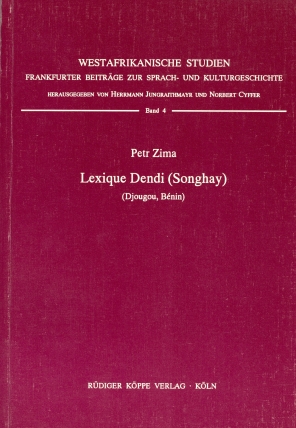


This small dictionary (about 2,500 lexical entries) deals with Dendi, a dialect of Songhay. The main dialects of the so called southern group of Songhay (Western Songhay, Eastern Songhay, Kaado, and Zarma) are spoken along the middle part of the Niger valley in Mali, Burkina Faso and Niger, whereas some dialects of the so called northern group are heard in the Saharan oases as far as Algeria.
The Dendi dialect is chiefly spoken at the south-eastern marges of the Songhay region, i.e. in Benin, Niger, Nigeria, and Ghana. The present book is a lexical and brief grammatical and phonological description (45 pp.) of the Dendi-Songhay dialect of Djougou (Benin), which is closely related to the Dendi dialects of Salaga (Northern Ghana) and Kandi/Parakou (Benin).
The author gained results througth his field studies in Dahomey/Benin and Ghana, which he was able to undertake with the help of the Czechoslovak Academy of Science (CSAV Prague). Within the scope of the Collaborative Research Centre 268 (Goethe University, Frankfurt/Main) these preliminary results were later revised and enlarged by other informants on Dendi.
In our programme you will find further analyses, descriptions and text collections on Songhay languages of West Africa and the history of the Songhay empire, see the links below:
Der Songhay-Komplex gehört zu den faszinierendsten Teilgebieten der Afrikanistik. Es ist daher um so begrüßenswerter, daß unsere Kenntnis über die umstrittenen Sprachformen, die unter dem Begriff Songhay zusammengefaßt werden, nunmehr durch ein bemerkenswert gründliches Werk zum südlichsten dieser Idiome, dem Dendi, erweitert wird. Das Erscheinen dieser Arbeit fällt glücklich in eine Zeit der fortgesetzten intensiven Bemühungen um verschiedene Songhayvarietäten. [...]
Hier liegt ein lange entbehrter, umfangreicher und solider Beitrag zur Lexikographie des Songhay-Komplexes vor, für den wir dem Autor Dank schulden. Ohne Zweifel wird Zimas Dendi-Wörterbuch die weitere Erforschung des Songhay und seiner enigmatischen Stellung im Kreis der afrikanischen Sprachen fördern.
H. Ekkehard Wolff in Afrika und Übersee, 80/1997, 144-147
The Songhay empire, with Gao as its ancient capital, developed into a major political power in West Africa that reached its climax in the fifteenth century. During its rise the Songhay language gained importance as a lingua franca along the river Niger, from Djenne in the west via Timbuktu and Say towards the east as far es Benin and the Agades (in Niger). Moreover, various speech communities apparently gave up their primary language in due course in favour of Songhay, which consequently became one of the main languages of West Africa. These areal contacts with typologically different languages, and shift-induced interference in the language shift process, also resulted in considerable dialectal and typological diversification within the expanding Songhay language.
When the emprire collapsed at the end of the sixteenth century, and when Moroccan armies marched into the area, groups of Songhay-speakers went down the river Niger and settled in the border area of Benin, Nigeria, Togo, and Ghana. It is this latter variety of Songhay, more specifically that of Benin (known as Dendi-Djogou), which forms the topic of Petr Zima’s book. The author has set himself a rather modest descriptive goal, that of documenting the phonological and grammatical features of this little-known eastern variety of Songhay, whose proper name, “dàndì”, ‘going downstream’, still reflects part of the ethnohistory of its speakers.
Gerrit J. Dimmendaal in Africa Bibliography, 77/4, 1996, 630-631
© 2026 by Rüdiger Köppe Verlag – www.koeppe.de